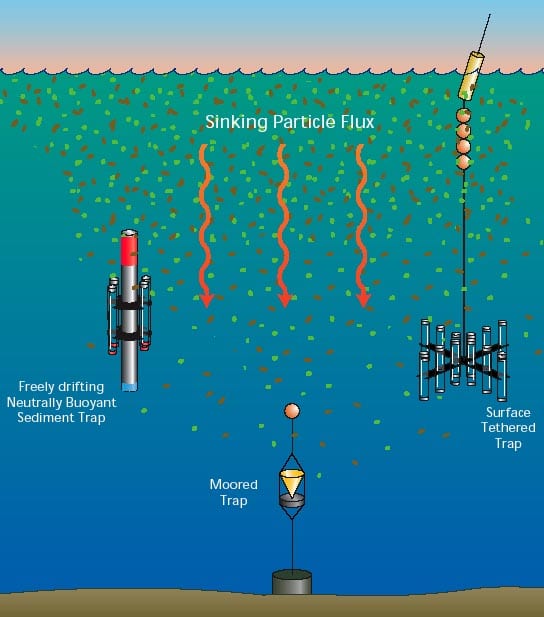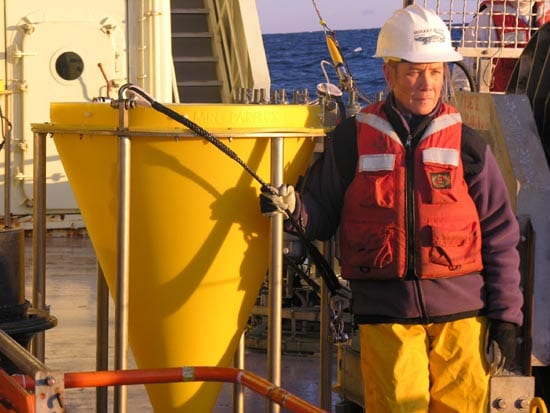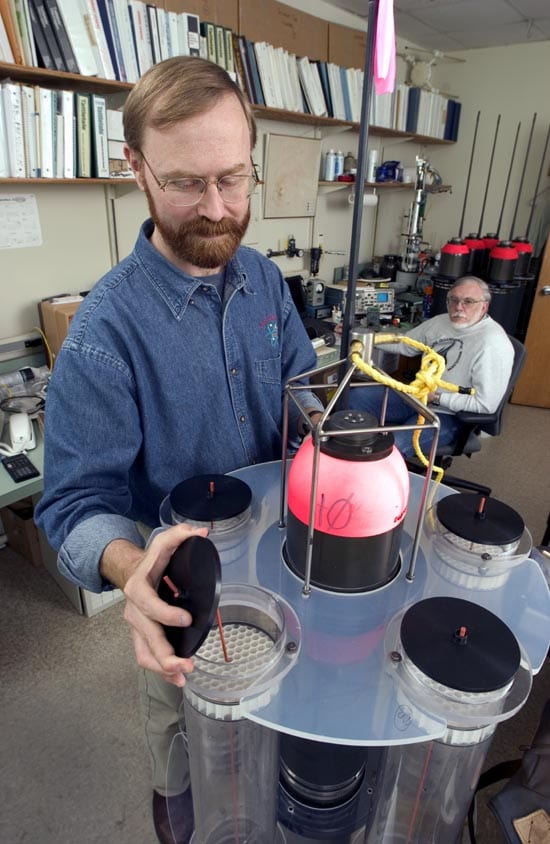Sediment Trap
What is a sediment trap and why do we use it?
Sediment traps are containers that scientists place in the water to collect particles falling toward the sea floor. The traps collect tiny sediment or larger accumulations called marine snow- made up of organic matter, dead sea creatures, tiny shells, dust and minerals.
Analyzing the samples helps scientists understand how fast nutrients and trace elements like carbon, nitrogen, phosphorus, calcium, silicon and uranium move from the ocean surface to the deep ocean. These materials are what almost all deep-sea life uses for food (since plants can’t grow in the dark). Other researchers analyze the trace elements for clues about ocean circulationthousands of years ago. And sediment trap data helps to understand the other end of the nutrient cycle: how upwelling currents create such productive fishing areas.
How do sediment traps work?
The basic sediment trap consists of a broad funnel with a collecting jar at the bottom. The funnel opening covers a standard area (such as 0.25 square meter [2.7 square feet]) and has baffles at the top to keep out very large objects that might clog the funnel.
The trap clamps at a specific depth to a fixed cable attached to an anchor or buoy. Traps are often placed very deep, where they can catch sediment near the ocean bottom.
When a ship returns to retrieve the trap, the crew activates a remote-controlled device called an acoustic release. The release severs the line between the trap and its anchor, and the trap floats to the surface with its samples.
The first sediment trap was deployed in 1978 off Bermuda, in more than 3,200 meters (2 miles) of water. In more recent experiments, several traps have been spaced every 500 meters from the upper ocean to 500 meters above the seafloor. By comparing the trap catches, scientists learn how much material gets recycled by sea life on its journey downward.
How have sediment traps been refined since 1978?
New, automated traps carry up to 21 collection vials on a motorized tray. The pre-programmed unit swaps out the vials at set intervals or when sensors on the unit record a change in water conditions. Each sealed vial stores information about a narrow slice of time, and together they allow the unit to operate continuously for up to a year.
Scientists studying the upper ocean use smaller traps that are easier to handle and collect multiple samples at the same time. In shallower waters, much more sediment falls through the water than at depth. That means upper-ocean sediment traps can forgo the bulky funnel top. They can be deployed for only a few days at a time and still collect useful samples.
But currents near the surface can be strong enough to push sediment past a trap the way rain can blow past a rain gauge. So scientists designed the neutrally buoyant sediment trap, which drifts with prevailing currents at a specified depth while catching falling sediment.
What have we learned using sediment traps?
Before sediment traps, scientists assumed that nutrients and the tiny bodies of plankton would sink very slowly, taking centuries or millennia to finally reach the sea floor. During the long descent, they reasoned, much of the material would re-dissolve or be consumed by sea life and never reach bottom. Just how deep-sea life could survive with so few nutrients arriving became a puzzle.
Sediment traps showed much larger particles (to 12 mm [0.5 inch] long) than scientists expected. This marine snow sinks as fast as 200 meters (656 feet) per day and can reach bottom in just a few weeks. At that speed, transient surface conditions, like a summer bloom of phytoplankton, can be felt on the sea floor in the form of a blizzard of marine snow.
Years of trap data now indicate that about 740 million metric tons (815 million tons) of carbon reaches the global sea floor every year. That’s about 1 percent of the ocean’s total production of carbon in a year. Scientists have made similar calculations for other important elements and nutrients.
What platforms are involved?
Sediment traps are usually mounted on the mooring cable of a subsurface or a surface buoy. The traps are bolted onto the lines at specific depths, where they remain for up to a year before a research vessel returns to collect the samples.
Advantages
Sediment traps are the only means for scientists to get hard data about the amounts and kinds of material that surface waters transport to the deep ocean.
Sturdy titanium construction means traps can be redeployed as soon as the collection vials are replaced.
Limitations
Sediment traps have to remain vertical in the water to work properly. Traps deployed in strong currents must continuously record their tilt angle so scientists can tell whether the samples have been compromised.
In deep water, it takes a long time to collect enough sediment for a sample - especially because, back on shore, scientists from a wide range of disciplines are waiting for a part of the sample.
The samples can bias themselves. The deep ocean is low on food, so a collection jar filled with sediment is a buffet for local zooplankton. In some traps, the majority of the catch can come from “swimmers” who arrive looking for a meal, and not from sediment at all. Trap designers are working on ways to keep live organisms out of the samples.
Sources
Susumu Honjo, Scientist Emeritus, Geology and Geophysics, Woods Hole Oceanographic Institution.
Steve Manganini, Research Specialist, Geology and Geophysics, Woods Hole Oceanographic Institution.
Ken Buesseler, Senior Scientist, Marine Chemistry and Geochemistry, Woods Hole Oceanographic Institution. Buesseler lab website ("Cafe Thorium").
Jim Valdes, Senior Engineer, Physical Oceanography, Woods Hole Oceanographic Institution.
Coale, K. H. Labyrinth of doom: a device to minimize the "swimmer" component in sediment trap collections. Limnology and Oceanography 35:1376-1381. (1990)
Honjo, S. Trapped particulate flux. p. 3045-3048 in J. H. Steele, K. K. Turekian and S. A. Thorpe (eds.), Encyclopedia of Ocean Science, Academic Press, San Diego, CA. (2001)
Lampitt, R. S. Marine snow. p. 1667-1675 in J. H. Steele, K. K. Turekian and S. A. Thorpe (eds.), Encyclopedia of Ocean Science, Academic Press, San Diego, CA. (2001)
Valdes, J. R., and J. F. Price. A neutrally buoyant, upper ocean sediment trap. Journal of Atmospheric and Oceanic Technology 17:62-68 [doi:10.1175/1520-0426(2000)017<0062:ANBUOS>2.0.CO;2]. (1999)
See Also
Catching the Rain: Sediment Trap Technology
A primer on how sediment traps work, from Oceanusmagazine
McLane Research Laboratories
Technical details and diagrams about McLane's product line
Aquatic Research Instruments
Technical details and diagrams of ARI's sediment traps
The Oceanic Flux Program
Twenty years of particle flux measurements in the deep Sargasso Sea. From Oceanus magazine
Maureen Conte
Dr. Conte, now at Bermuda Biological Station for Research, leads the Oceanic Flux Program(see above link)




